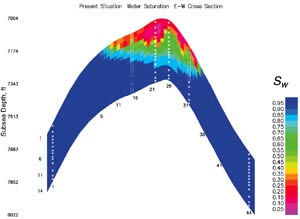|
V RaptureChrist Newsletter
|
||||||||
The world now faces a terrible crisis. Not only will the price of oil go up, but in the near future it may become rationed or simply unavailable. The three largest oil exporters are Saudi Arabia, Iraq, and Iran.
Saudi Arabia has 25% of the world's proven oil reserves, 60% of that production comes from one giant oil field, the Ghawar field, an oilfield so gigantic that there is nothing like it on earth. The Ghawar field was first developed in 1951. At its peak it could produce about 5.7 million barrels of oil per day (mbd), but this oil field is getting old and in order to maintain production now at 4 mbd, the Saudi's are injecting seawater into the oilfield to force the oil up. The output at the wellhead is about 30% water. It now takes three gallons of seawater for every gallon of oil they get out, and the oil fraction will go down as the well gets older. The Saudis dispute Simmons claims.
The Saudi's have many small oil fields, but none that can replace Ghawar. But the titan is dying and the world does not have any spare capacity. The seconds largest oil field is Burgen in Kuwait. It is much smaller and also nearing the end of its life. According to Kjell Aleklett, president of the Association for the Study of Peak Oil and Gas, "Fifty percent of all the oil we are using today is just from something like 150 oil fields, and there is something like 40,000 [oil fields] in the world." In spite of new technology and a desperate search, no large fields have been found since 1968. Look at it this way, no large oil supertankers have been built for over 20 years and no large oil refineries have been built since 1976. WHY? That is because the oil companies know that the world supply of oil is in permanent decline. As the world becomes aware of this precarious situation, expect the price at the pump to soar. Crude oil is used not only for gasoline, but to produce plastics, medicines, chemicals. Our current lifestyle depends on inexpensive oil. |
What if I told you that 80% of the oil in Saudi Arabia is now non-recoverable due to overproduction of oil wells. In other words, in order to extract the last drop of oil, they are injecting seawater into the wells. By doing so the delicate structures inside the porous walls of the rock reservoir are damaged. Much of the Saudi oil we are so desperately counting on - is now unrecoverable. Excessive production damaged the wells.
According to Simmons, "The technical term for damaging an oilfield by overproduction is 'rate sensitivity'. In other words, if the oil is pulled out of the ground too fast, it damages the fragile geological structure of the field. This can make as much as 80% of the oil within the field unextractable." Other oil producing countries have also overproduced their wells. Iran has pumped natural gas into its oil wells instead of seawater. This is worse because valuable natural gas is lost which leaks out faster than water. In Iraq, the Rumelia oil field in the south, which produces 60% of Iraq's oil, is also damaged. Simmons says "The most serious problems that the Iraq oil system has is the two old giant oil fields, Kirkuk and Rumelia, were basically around 80-85% of their sustainable oil production in the 80s and 90s and both of those fields have been terribly abused over the last two years, and they finally were able to, about six to nine weeks ago, to let two contracts to have the first serious reservoir studies done of those fields since the late 1970s. And my sense is that what the reservoir field studies will show, if they are done properly, is that they basically destroyed those two fields." According to Luis Ramirez, head of exploration and production at Pemex "Output from Mexico's biggest oil field, Cantarell, will decline 14 percent a year from 2006." Present production is 2.2 million barrels of oil per day. This one field supplies 2/3 of Mexico's total oil output, and it is very important to the US. Pemex has been using nitrogen-injection technology at its biggest oilfield Cantarell to boost reservoir pressure and keep production at over two million barrels per day. It uses 1.2 billion cubic feet per day of compressed nitrogen to reverse pressure loss. This will artificially boost production in the near term, but at the cost of decreasing total oil recovery. |
|||||||


